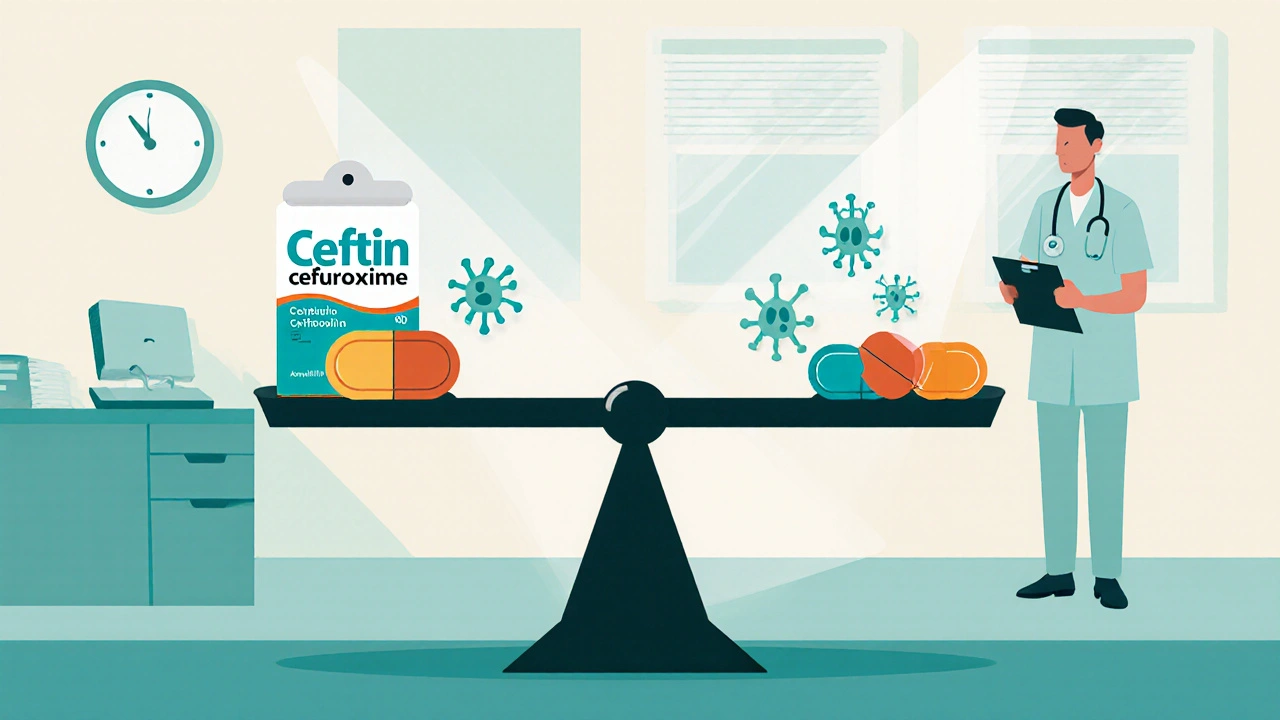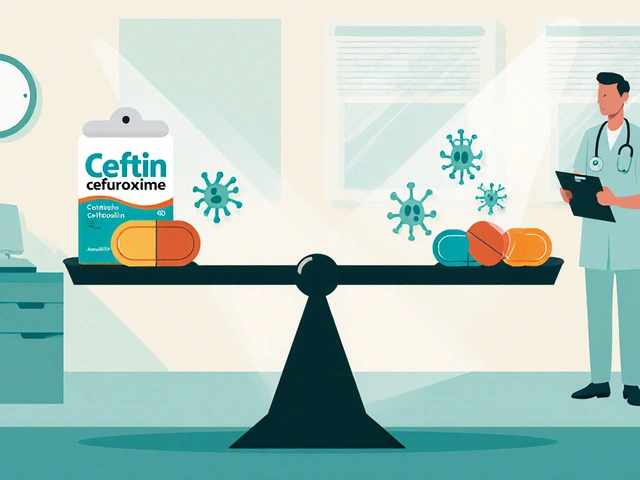Antibiotic Selection Guide
Which Antibiotic Is Right for Your Infection?
Answer a few questions about your symptoms and medical history to see which antibiotic might be most appropriate for your infection.
Recommended Antibiotic
When your doctor prescribes Ceftin (cefuroxime), you might wonder: is this really the best option? Maybe you’ve heard about amoxicillin, azithromycin, or cephalexin and are curious if they could work just as well-or better. You’re not alone. Many people ask this question, especially when they’ve had side effects before or when a previous antibiotic didn’t help. The truth is, not all antibiotics are the same. Choosing the right one depends on what’s making you sick, your medical history, and even your body’s reaction to certain drugs.
What Is Ceftin (Cefuroxime)?
Ceftin is the brand name for cefuroxime, a second-generation cephalosporin antibiotic used to treat bacterial infections like sinusitis, bronchitis, pneumonia, ear infections, and urinary tract infections. It was first approved in the U.S. in the 1980s and remains a common choice because it works against a broader range of bacteria than first-gen drugs like cephalexin.
Unlike penicillin, which only targets certain types of bacteria, cefuroxime can handle both Gram-positive and some Gram-negative strains. That makes it useful when the exact bug isn’t known yet. It’s usually taken twice a day, with food to improve absorption. Most people finish a 7- to 10-day course and feel better within a few days.
But here’s the catch: Ceftin isn’t always the first choice. Many doctors start with cheaper, simpler options like amoxicillin-unless they suspect resistance or a more complex infection.
Common Alternatives to Ceftin
There are several antibiotics that doctors consider when deciding whether Ceftin is the right fit. Here are the most common ones and how they stack up.
Amoxicillin
Amoxicillin is a penicillin-type antibiotic, often the go-to for ear infections, strep throat, and mild pneumonia. It’s cheaper than Ceftin, usually taken three times a day, and works well for many common infections.
But if you’ve had a penicillin allergy-or if your infection is caused by bacteria that have built up resistance to penicillin-amoxicillin won’t help. That’s where Ceftin comes in. It’s less likely to be affected by those same resistance patterns.
Cephalexin (Keflex)
Cephalexin is a first-generation cephalosporin, similar to Ceftin but narrower in scope. It’s great for skin infections like cellulitis or simple urinary tract infections. But it doesn’t cover as many Gram-negative bacteria as cefuroxime does.
For example, if you have a sinus infection caused by Hemophilus influenzae, cephalexin might fail where Ceftin succeeds. That’s why doctors often pick Ceftin for respiratory infections and cephalexin for skin or soft tissue issues.
Azithromycin (Zithromax)
Azithromycin is a macrolide antibiotic, not a cephalosporin. It’s often used for respiratory infections like bronchitis or walking pneumonia, especially in people allergic to penicillin or cephalosporins.
One big advantage? Azithromycin is usually taken just once a day for 3 to 5 days. That’s easier than Ceftin’s twice-daily schedule. But it’s not as effective against some bacteria that Ceftin handles well, like certain strains of Streptococcus pneumoniae. Also, overuse of azithromycin has led to rising resistance in some areas.
Ciprofloxacin (Cipro)
Cipro is a fluoroquinolone, a stronger class of antibiotic used for more serious infections like complicated UTIs, kidney infections, or even anthrax exposure. It’s not a first-line choice for simple infections because of serious side effects-tendon damage, nerve problems, and even long-term risks like aortic rupture.
Doctors avoid cipro unless they have to. Ceftin is safer for most people and just as effective for common infections. Cipro is overkill for a sinus infection and carries more risk.
Clarithromycin
Like azithromycin, clarithromycin is a macrolide. It’s often paired with other drugs to treat stomach ulcers caused by H. pylori. It’s also used for sinus and lung infections, especially in patients who can’t take penicillin.
But it’s not as broad-spectrum as Ceftin. It doesn’t cover many Gram-negative bacteria well. Plus, it can interact with other medications, including statins and blood thinners, making it trickier to use safely.
Head-to-Head Comparison: Ceftin vs. Top Alternatives
| Antibiotic | Class | Typical Uses | Dosing Frequency | Allergy Risk | Resistance Concerns |
|---|---|---|---|---|---|
| Ceftin (Cefuroxime) | Second-gen cephalosporin | Sinusitis, bronchitis, pneumonia, UTIs, ear infections | Twice daily | Low (if no cephalosporin allergy) | Moderate |
| Amoxicillin | Penicillin | Strep throat, ear infections, mild pneumonia | Three times daily | High (10% of people report allergy) | High in many areas |
| Cephalexin | First-gen cephalosporin | Skin infections, simple UTIs | Two to four times daily | Low (if no cephalosporin allergy) | Low to moderate |
| Azithromycin | Macrolide | Bronchitis, walking pneumonia, STIs | Once daily (3-5 days) | Low | Rising, especially in respiratory bugs |
| Ciprofloxacin | Fluoroquinolone | Complicated UTIs, kidney infections, anthrax | Twice daily | Low | High, due to overuse |
| Clarithromycin | Macrolide | Sinusitis, H. pylori, lung infections | Twice daily | Low | Moderate |
Looking at this table, you can see Ceftin hits a sweet spot: it’s broad enough for common respiratory and urinary infections, safer than fluoroquinolones, and more reliable than first-gen cephalosporins or penicillins in areas with high resistance.

When Is Ceftin the Best Choice?
Ceftin shines in three main situations:
- You have a suspected bacterial sinus or lung infection and can’t take penicillin.
- Your doctor suspects resistance to amoxicillin or cephalexin based on past treatment failures.
- You need a once- or twice-daily dose that’s more convenient than multiple daily pills.
It’s also often used when a child has recurrent ear infections or when an adult has a UTI caused by bacteria that don’t respond to trimethoprim-sulfamethoxazole.
But it’s not magic. If your infection is viral-like a cold or flu-Ceftin won’t help. Antibiotics don’t work on viruses. Taking them anyway just increases your risk of side effects and contributes to antibiotic resistance.
Side Effects and Risks
All antibiotics come with risks. Ceftin’s most common side effects are mild: diarrhea, nausea, vomiting, and stomach pain. About 5% of people report these. A rare but serious risk is Clostridioides difficile (C. diff) infection, which causes severe diarrhea and can be life-threatening.
If you’ve had C. diff before, your doctor might avoid Ceftin or choose something else. Allergic reactions are rare but possible-rash, itching, swelling, or trouble breathing. If you’ve had an allergic reaction to any cephalosporin or penicillin, don’t take Ceftin.
Compared to azithromycin, Ceftin is less likely to cause heart rhythm issues. Compared to ciprofloxacin, it’s far less likely to damage tendons or nerves. That’s why it’s often the middle-ground pick: effective, but with fewer serious risks than the strongest options.
Cost and Accessibility
Ceftin is available as a generic (cefuroxime), which makes it affordable. In the U.S., a 10-day course of generic cefuroxime 500mg usually costs $15-$30 without insurance. Brand-name Ceftin can be $100 or more.
Amoxicillin is cheaper-often under $10 for a full course. Cephalexin is similarly priced. Azithromycin can be $20-$40, depending on the dose. Ciprofloxacin is often covered by insurance but can cost $50+ out-of-pocket.
Most pharmacies carry cefuroxime, and it’s included in most insurance formularies. But some insurers require prior authorization if you’re switching from amoxicillin, especially for simple infections.

What to Ask Your Doctor
If you’ve been prescribed Ceftin-or are considering alternatives-here are five smart questions to ask:
- Is this infection definitely bacterial? Could it be viral?
- Why did you choose Ceftin instead of amoxicillin or cephalexin?
- Have I had any antibiotic resistance in the past?
- What are the most common side effects, and what should I watch for?
- Is there a cheaper or simpler option that would work just as well?
Doctors don’t always explain the reasoning behind antibiotic choices. Asking these questions helps you understand your treatment-and sometimes leads to a simpler, safer, or cheaper option.
Final Thoughts: Is Ceftin Right for You?
Ceftin isn’t the most powerful antibiotic, and it’s not always the cheapest. But it’s often the smartest middle ground. It works where amoxicillin fails, it’s safer than cipro, and it’s more reliable than cephalexin for chest and sinus infections.
If you’ve had repeated infections that didn’t respond to other antibiotics, Ceftin might be the key. If you’re allergic to penicillin, it’s a solid backup. If you need something that’s effective but not overly aggressive, it’s a great option.
But remember: antibiotics aren’t interchangeable. The right one depends on your body, your infection, and your history. Never switch or stop antibiotics without talking to your doctor-even if you feel better. Stopping early can make the infection come back stronger.
When in doubt, ask. Your health is worth the conversation.
Can I take Ceftin if I’m allergic to penicillin?
About 10% of people with a penicillin allergy also react to cephalosporins like Ceftin. But many don’t. If your penicillin reaction was mild (like a rash), your doctor might still prescribe Ceftin with caution. If you had a severe reaction-like anaphylaxis, swelling, or trouble breathing-you should avoid it. Always tell your doctor exactly what happened during your past reaction.
Is Ceftin stronger than amoxicillin?
Not necessarily stronger, but broader. Amoxicillin covers many common bacteria well, but Ceftin works against more types, especially some Gram-negative ones like Hemophilus influenzae and Moraxella catarrhalis. If your infection didn’t respond to amoxicillin, Ceftin might be the next step-not because it’s stronger, but because it hits more targets.
Can I use azithromycin instead of Ceftin for a sinus infection?
Sometimes, but not always. Azithromycin works for some sinus infections, especially if they’re linked to bronchitis or if you’re allergic to penicillin. But studies show it’s less effective than Ceftin against the most common bacterial causes of sinusitis. If your doctor suspects a bacterial infection, Ceftin is usually preferred.
Does Ceftin cause yeast infections?
Yes, it can. Like most antibiotics, Ceftin kills off good bacteria in your gut and vagina, which can let yeast overgrow. Vaginal yeast infections are common after antibiotic use. If you’re prone to them, your doctor might recommend an antifungal cream or pill at the same time. It’s not dangerous, but it can be uncomfortable.
How long does it take for Ceftin to start working?
Most people notice improvement in symptoms like fever, pain, or congestion within 24 to 48 hours. But you should still finish the full course-even if you feel fine. Stopping early can let the toughest bacteria survive and come back stronger. If you don’t feel better after 3 days, call your doctor. The infection might be viral, resistant, or something else.
Can I drink alcohol while taking Ceftin?
There’s no dangerous interaction between Ceftin and alcohol. But drinking while you’re sick isn’t a good idea. Alcohol can weaken your immune system, dehydrate you, and make side effects like nausea or dizziness worse. It’s best to avoid it until you’re fully recovered.
What to Do Next
If you’re on Ceftin, take it exactly as prescribed. Keep track of how you feel. Note any side effects. Don’t save leftover pills for next time-antibiotics expire, and using old ones can be dangerous.
If you’re considering alternatives, talk to your doctor before switching. Don’t assume a cheaper or “natural” option is better. Antibiotics are medicines, not supplements. The wrong choice can delay recovery or lead to complications.
And if you’ve had multiple infections in a short time, ask about testing for antibiotic resistance. Knowing what bugs you carry-and which drugs they resist-can help your doctor choose better next time.





Comments
Oh sure, let’s just trust Big Pharma’s ‘middle-ground pick’ like it’s not a marketing ploy designed to sell you a $30 generic instead of a $5 amoxicillin. 🤡 Next they’ll tell us Ceftin is ‘safely’ erasing our gut biome so we can pay for probiotics on Amazon. Antibiotics aren’t snacks. They’re chemical warfare-and someone’s always profiting from your cough.
lol so Ceftin is the ‘smart middle ground’?? bro i took cephalexin for a sinus infection and woke up with a fungal rash that looked like a map of canada. then my cousin took azithromycin and got ‘walking pneumonia’ from it. now i think ALL antibiotics are just government mind control to make us dependent on pills. also i heard they add fluoride to make you forget you’re being poisoned. 🧠💧
While the article presents a reasonably structured comparative analysis of cephalosporins and alternative antimicrobial agents, it notably underemphasizes pharmacokinetic variability across patient populations. The dosing frequency of cefuroxime, for instance, assumes standard renal clearance-ignoring elderly patients or those with CKD, where dose adjustment is clinically mandated. Furthermore, the assertion that Ceftin is ‘safer than fluoroquinolones’ is statistically valid but clinically reductive; adverse event profiles must be contextualized by comorbidities, polypharmacy, and duration of therapy. A more rigorous discussion of therapeutic drug monitoring would have elevated this piece.
HAHAHAHAHA you westerners think your antibiotics are magic? In India, we’ve been using turmeric, neem, and garlic since before your grandmas were born. Ceftin? Pfft. We don’t need your colonial pharma pills to cure a cold. And now you want us to pay $30 for something our grandmothers cured with boiled tulsi leaves? Your ‘middle ground’ is just another way to make us poor people dependent on your expensive poison. Wake up, sheeple!
The comparative efficacy data presented is methodologically sound, yet the omission of resistance prevalence by geographic region constitutes a significant analytical gap. Regional disparities in beta-lactamase production, particularly in community-acquired respiratory pathogens, substantially alter the clinical utility of second-generation cephalosporins. Moreover, the cost analysis fails to account for indirect costs associated with treatment failure, hospitalization, or subsequent antibiotic escalation. A comprehensive economic model would be required to validate the assertion of ‘optimal middle ground.’
As a pharmacist with 18 years in community practice, I’ve seen this play out countless times. Patients come in demanding azithromycin because they saw it on TikTok, or refuse Ceftin because they ‘heard it causes yeast infections’-which, yes, it can, but so can every antibiotic that isn’t narrow-spectrum. The real issue isn’t the drug-it’s the misinformation. I always explain: Amoxicillin is first-line for uncomplicated cases because it’s cheap, effective, and has a decades-long safety track record. Ceftin is reserved for when resistance is suspected, when penicillin allergy is confirmed, or when compliance is a concern (twice daily is easier than three times). But no, people want the ‘newer’ or ‘stronger’ one. It’s not about strength. It’s about precision. And yes, if you’re prone to yeast infections, take a probiotic. It’s not rocket science.
Baseline resistance profiles for S. pneumoniae in North America now exceed 25% for penicillin and 15% for macrolides-per CDC 2023 surveillance. Ceftin’s MIC90 remains below 0.5 µg/mL for most respiratory isolates, making it a rational empirical choice in high-resistance settings. Cephalexin’s spectrum is inadequate for M. catarrhalis and H. influenzae, which constitute >40% of acute bacterial sinusitis cases. The table is accurate. The real failure is in primary care education-clinicians default to amoxicillin out of habit, not evidence. This is not a drug issue. It’s a diagnostic inertia problem.
Hey! I just wanted to say I loved this post! 😊 I actually had a sinus infection last winter and my doctor gave me Ceftin after amoxicillin didn’t work-same story as the article! I felt so much better by day 3 and didn’t get any yeast issues (thank you, yogurt!). Also, the part about not saving leftover pills? SO IMPORTANT. I used to hoard antibiotics like they were gold coins… not anymore! 🙌 Thanks for making it so clear and not scary. You’re awesome!
Wow, this is such a clear breakdown! I’ve been researching antibiotics since my last UTI and I’m so glad I found this. I never realized how different cephalosporin generations were-like, I thought all ‘ceph’ drugs were the same. Now I get why my doc switched me from cephalexin to cefuroxime after two failed rounds. Also, the alcohol note? Perfect. I was wondering if I could have wine with dinner. Turns out, nope. Not because of the drug, but because my body’s already fighting a war. I’m not gonna add beer to the battlefield. 🍷❌ Thank you for the wisdom!
Let’s be honest: Ceftin is just another weapon in the pharmaceutical arsenal designed to keep you dependent. The FDA approves these drugs not because they’re safest, but because they’re profitable. The ‘low allergy risk’ claim ignores cross-reactivity studies showing up to 18% of penicillin-allergic patients react to cephalosporins. And why is this ‘middle ground’ so aggressively marketed? Because it’s the perfect balance of efficacy and profit. They don’t want you to know that penicillin still works for 80% of cases. They want you to believe you need the ‘upgrade.’
OMG I just took Ceftin and now I’m basically a fairy princess who glows with health ✨ But also, I think the government put mind-control chips in the pills. Just saying. 😇 Also, I cried when I read about the yeast infection part-like, why does this happen to me?! 😭 I’m just trying to be healthy!!
There’s a lot of truth here, but I’d add one thing: timing matters. If you’re on Ceftin and don’t feel better in 72 hours, it’s not necessarily resistance-it could be a viral co-infection, or the wrong diagnosis. I’ve seen patients stop antibiotics too early because they felt ‘fine’ after 4 days. Then the infection came back with a vengeance. Don’t just wait for symptoms to vanish. Wait for the full course. Your immune system needs the support, not the sabotage. And yes, probiotics help-but not if you take them at the same time as the antibiotic. Space them out by 2-3 hours. Small details matter.
What strikes me most is how we’ve reduced complex biological systems to a checklist of drugs and symptoms. We treat infections like puzzles to be solved with the right key, but the body is not a lock. It’s an ecosystem. Ceftin, amoxicillin, azithromycin-they’re all tools, yes. But the real question isn’t ‘which antibiotic?’ It’s ‘why did this infection take hold?’ Maybe we’re ignoring sleep, stress, or gut health. Antibiotics are necessary sometimes-but they’re not the answer. They’re a pause button. The real healing? That’s still up to us.